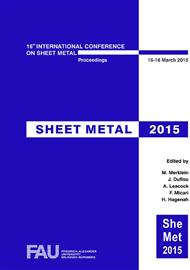[1]
F.F. Zhang, J. Chen, J.S. Chen, J. Lu, G. Liu, S.J. Yuan, Overview on constitutive modeling for hydroforming with the existence of through-thickness normal stress, J Mater Process Techno., 212 (2012) 2228-2237.
DOI: 10.1016/j.jmatprotec.2012.06.018
Google Scholar
[2]
R. Hauptmann, K. Schweizerhof, A systematic development of solid-shell, element formulations for linear and non-linear analyses employing only displacement degrees of freedom, Int J Numer Meth Engng., 42 (1998) 49-69.
DOI: 10.1002/(sici)1097-0207(19980515)42:1<49::aid-nme349>3.0.co;2-2
Google Scholar
[3]
M. Robinson, An evaluation of the errors in the yield surface for a rotationally symmetric thin shell due to neglecting transverse normal stresses and shell curvature, Int J Mech Sci., 42(2000) 1087-1095.
DOI: 10.1016/s0020-7403(99)00037-5
Google Scholar
[4]
J.C. Simo, M.S. Rifai, A class of mixed assumed strain methods and the method of incompatible modes, Int J Numer Meth Engng., 29 (1990) 1595-1638.
DOI: 10.1002/nme.1620290802
Google Scholar
[5]
N.E. Abbasi, S.A. Meguid, A new shell element accounting for through-thickness deformation, Comput Methods Appl Mech Engng., 189 (2000) 841-862.
DOI: 10.1016/s0045-7825(99)00348-5
Google Scholar
[6]
R. J, Alves de Sousa, R.P.R. Cardoso, R.A. Fontes Valente, J.W. Yoon, J.J. Gracio, R.M. Natal Jorge, A new one-point quadrature enhanced assumed strain (EAS) solid-shell element with multiple integration points along thickness: Part 1-geometrically linear applications, Int J Numer Meth Engng., 62(2005).
DOI: 10.1002/nme.1226
Google Scholar
[7]
R. J, Alves de Sousa, R.P.R. Cardoso, R.A. Fontes Valente, J.W. Yoon, J.J. Gracio, R.M. Natal Jorge, A new one-point quadrature enhanced assumed strain (EAS) solid-shell element with multiple integration points along thickness: Part 2-nonlinear applications, Int J Numer Meth Engng., 67 (2006).
DOI: 10.1002/nme.1609
Google Scholar
[8]
R.P.R. Cardoso, J.W. Yoon, M. Mahardika, S. Choudhry, R.J. Alves de Sousa, R.A. Fontes Valente, Enhanced assumed strain (EAS) and assumed natural strain (ANS) methods for one-point quadrature solid-shell elements, Int J Numer Meth Engng., 75 (2008).
DOI: 10.1002/nme.2250
Google Scholar
[9]
H. Lu, K. Ito, K. Kazama, S. Namura, Development of a new quadratic shell element considering the normal stress in the thickness direction for simulating sheet metal forming, J Mater Process Techno., 171 (2006) 341-347.
DOI: 10.1016/j.jmatprotec.2005.06.081
Google Scholar
[10]
D.N. Kim, K.J. Bathe, A 4-node 3D-shell element to model shell surface tractions and incompressible behaviour, Comput Struct., 86 (2008) 2027-(2041).
DOI: 10.1016/j.compstruc.2008.04.019
Google Scholar
[11]
J.W. Cho, D.Y. Yang, W.J. Chung, A simplified approach for incorporating thickness stress in the analysis of sheet metal forming using shell elements, Int J Numer Meth Engng., 53 (2002) 2311-2327.
DOI: 10.1002/nme.379
Google Scholar
[12]
J.C. Ng, S.G. Luckey, G.T. Kridli, P.A. Friedman, Validation of a modified material model for use with shell elements to improve the predictive accuracy of the thickness distribution in superplastic forming of sheet metals, J Mater Process Techno., 211 (2011).
DOI: 10.1016/j.jmatprotec.2011.03.012
Google Scholar
[13]
D. Banabic, F. Barlat, O. Cazacu, T. Kuwabara, Advances in anisotropy and formability, Int J Mater Form., 3 (2010) 165-189.
DOI: 10.1007/s12289-010-0992-9
Google Scholar
[14]
F. Barlat, D.J. Lege, J.C. Berm, A six-component yield function for anisotropic materials, Int J Plast., 7 (1991) 693-712.
DOI: 10.1016/0749-6419(91)90052-z
Google Scholar
[15]
T. Belytschko, W.K. Liu, B. Moran, Nonlinear finite elements for continua and structures, first ed., John Wiley and Sons, England, 2001, pp.287-288.
Google Scholar
[16]
J.W. Yoon, F. Barlat, R.E. Dick, K. Chung, T.J. Kang, Plane stress yield function for aluminum alloy sheets-Part II: FE formulation and its implementation, Int J Plast., 20 (2004) 495-522.
DOI: 10.1016/s0749-6419(03)00099-8
Google Scholar


